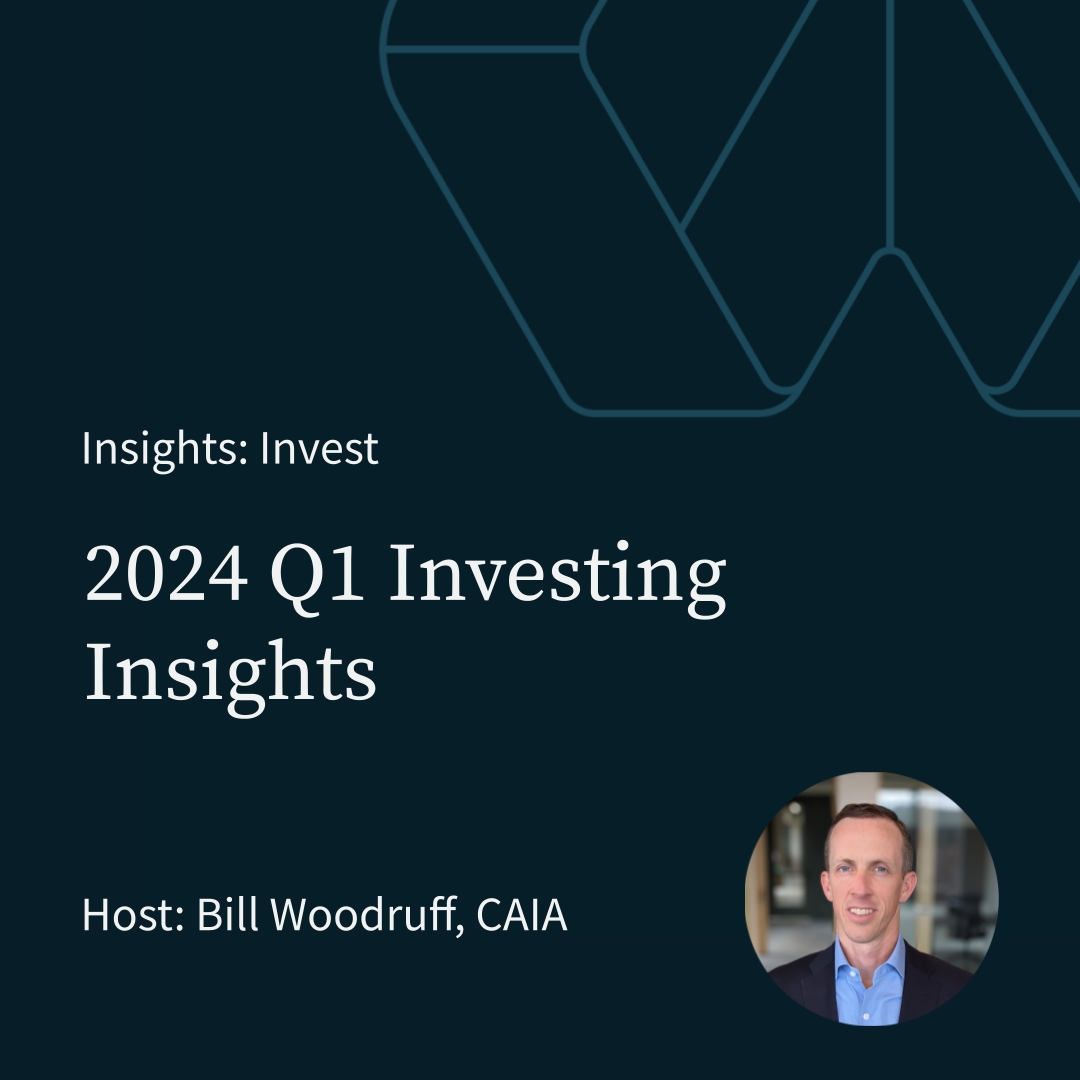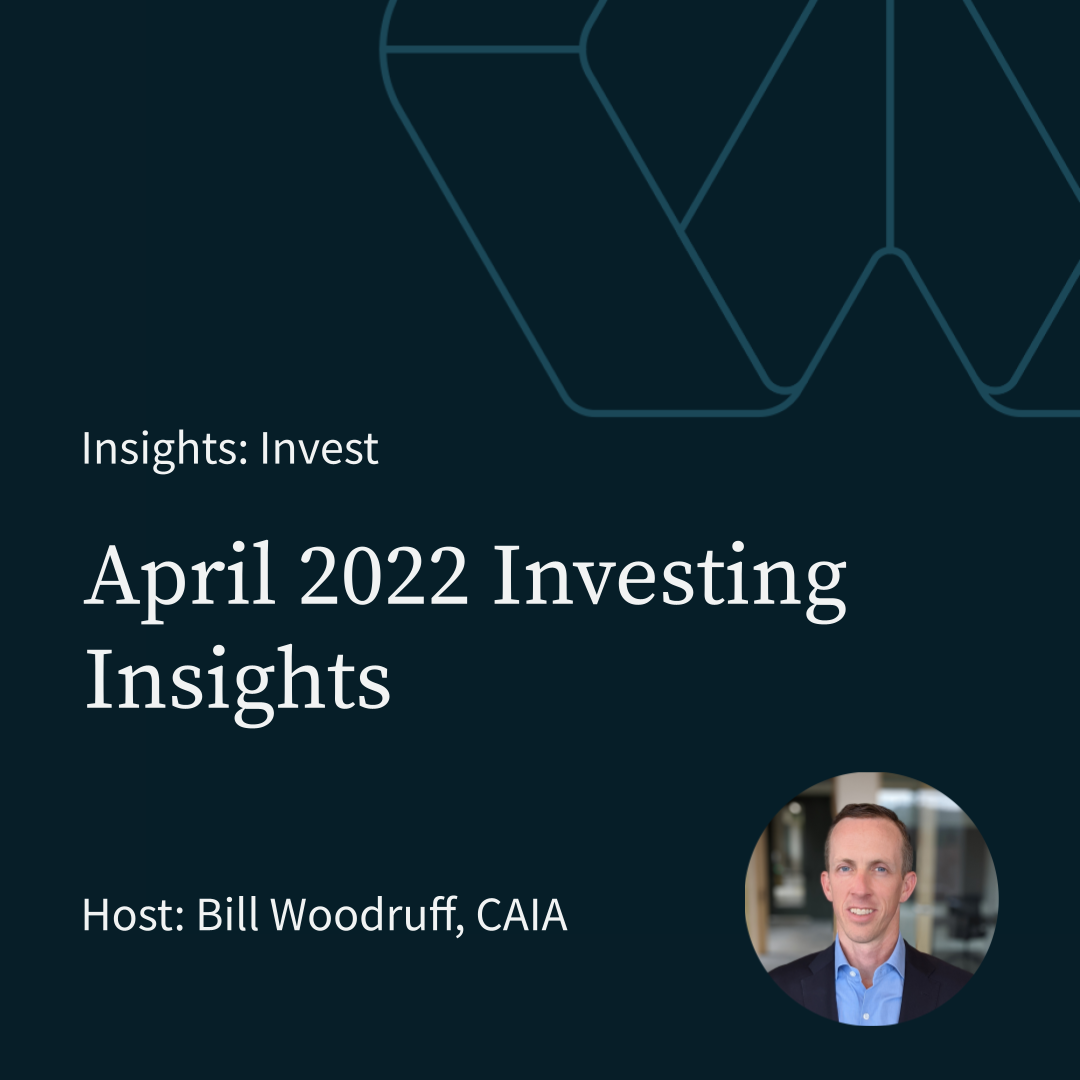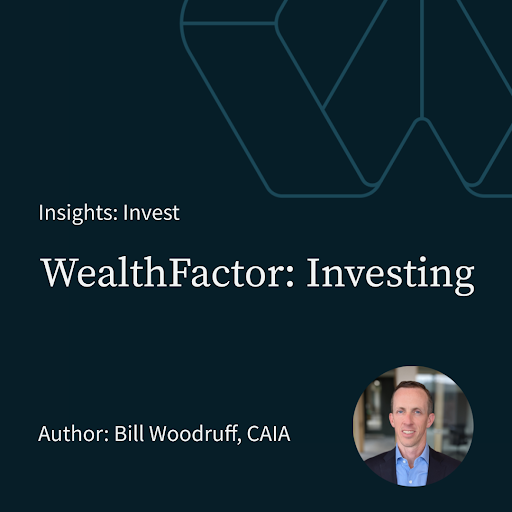Q1 2022 Investing Insights
Slides:
Replay:
Transcript:
Hi, good afternoon. My name is Bill Woodruff. I'm the founder of WealthFactor and act as its chief investment officer. Today, we I will be going through our quarterly Investing Insights. Before I get too far in a few words for compliance purposes, this call is for informational purposes only and may be recorded statements made during this call or the opinions of the speaker and are subject to risk and uncertainty, some of which are significant in scope. And by their very nature beyond the control of wealth factor, there can be no assurance that such statements will prove to be accurate and actual results and future events could differ in a material way from set statements. Historical results are not necessarily indicative of future performance. So I founded wealth factor just by way of introduction, really based on the idea that most of the investment related and wealth related services industries are built around too many different layers of people, process and products. And I believe that those things generally don't add a whole lot of value, but in fact, may detract in the forms of increased levels of complexity and increased levels of risk. Today, we're going to go through our quarterly conversation, and share some insights and thoughts. And we do this intentionally, no more often than quarterly. Because for very good reasons. It's my belief that in today's age, whether it's the media or social media, or just the idea of consuming content, we're so incentivized as businesses including the media as a business, to share information all the time and keep mindshare and focus. And I believe that that as a practice may actually lead you to transact more based on that additional, or being flooded with information. And I think do it the more you transact, or react to things in go on in global financial markets, the more you reduce the probability that you might have a successful outcome. So it well factor we're a wealth services company focused on delivering our services digitally. But augmenting that with access, direct access to true subject matter, wealth experts, our investment, philosophy and approach, we call it risk smart. And I sort of shared some of our thoughts around portfolio smart in terms of why we created wealth factor. But in effect, the tenants of being portfolio smart are keeping things simple, eliminating unnecessary layers, and generally trying to avoid investing, that's determined that the success is determined by picking and or timing. The next component of being risk smart is being fee smart. I think fees are one of two things that we have a lot of control over as investors and we should be very aware of those things. And the last element is tax smart. I believe that proactive and personalized tax management may be the single greatest area that an investment related service provider can add value within.
So the agenda for today is to cover these four elements. And so first, I'm going to kick things off with some sort of top level thoughts asking the question is this time different? I'm going to spend a little time in the following three areas that are probably the most notable or are receiving the most attention in the media and by financial or investment practitioners. So I'm going to spend some time on commodity prices, inflation, interest rates in fixed income, and then a topic that AI has been a reoccurring theme for me in the last several quarters, a quick update on the state of growth stocks versus value stocks, specifically here in the United States. So asking the question, is this time different? I always, global events and economic events are always different by their nature. But that doesn't mean that we should act on them or that it's going to change. What have been the long run dynamics of and price changes for financial assets and real assets. over time. So in this, we've got the top decades 1980 90 92,000 2010 2020. The second column, we're showing the returns for those years. And then the third column, we're showing the compound growth of $10,000 over the entire period, which the period shortens over time. So in the 80s, and it's fun to start with the 80s, we've got rapid inflation, very high inflation, and that's perhaps relevant to today. And then as you can see, there's a smattering of other events that are all very, very important or seem very important, very serious at the time, but the point and then at the bottom, we have 2020. And then we've created a kind of unique period, just the beginning of 2022. And so we're, the point I would make here is that the things that the media wants to sensationalize are while they're different, every time it's different, that they probably with a with a reasonably high degree of certainty, especially if the last 100 years or any guide are a reason to change. What we're trying to accomplish from an investment plan implementation or a portfolio perspective. It's my belief that to maximize the probability of success, one should have the right amount of risk, the right personalizations in their portfolio, and have a plan that defines that and that they should stick to that plan, knowing that things like inflation increases, Russia invading Ukraine, the threats of a recession are things that are persistently there. And as if you were to look back across history, consistently, the recipe for investing success on average, I mean, granted, there's always the very low probability of being the next Warren Buffett or uncovering in advance of when he generated most of his returns, or picking the next hot manager. You know, Cathy wood and Ark innovation come to mind in 2018, and 19, and 2020 to start that off, perhaps. But realistically, those pursuits are more likely to have one deviate from their disciplined investment plan, and generally are more likely to reduce the probability of successful investment outcomes over time.
So transitioning to primarily commodities are the thing, I'm going to spend a little bit of time on this chart. And there's a lot of data and a lot of business here. But so what this is, is a variety of asset classes each year, and then their performance, organized by best to worst, top to bottom. And so that what I would highlight here is commodity specifically. So commodities are thought to be an asset that might do well during inflationary periods. And so I'm going to spend a little bit of time talking about inflation here on this page as well. But commodities on a year, so far this year, have done really, really well. However, if you look back over this entire period, 2007 to 2021 commodities as an investment have done very, very poorly. And generally, whether it's inflation, or say commodities, and generally, generally, over the very long run financial assets, both stocks and bonds have have outpaced and certainly stocks when I make this comment, inflation and commodities. And, and so, as I think about the idea of owning commodities, or utilizing something like a commodity, or gold as a as the most asked about commodity example, I believe that to be to have to use gold, or any commodity in a portfolio and have that add value. Your success is largely driven by your ability to have when you own that and when you sell it. And I believe that those efforts are less than likely to be fruitful relative to buying and holding a broadly diverse portfolio of financial assets. So commodities, I would also add that when we if we think about the environment for inflation, or and this is potentially a segue into the next concept, or the potential for interest rates to continue to rise. We Know, the market moves very quickly. And it's reflected in the increases in commodity prices. We as investors don't really know anything more about the future than what's happened, or what's already happened and perhaps already reflected in, in, in both the market dynamics for inflation, interest rates and commodities. And so to react and say sell fixed income, because interest rates have increased or buy commodities, based on a fear of additional inflation. In order for that to be successful, you have to accurately predict that inflation and or interest rates will continue to rise, or in the case of inflation stay high, which I would contend is difficult, if not impossible. The next concept here is actually just an update on valuation dispersions in the market. So in a segue, a quick contributing element to the concepts I'm going to share in regards to growth and value. So we can see that there was a record or very high, maybe record as an overstatement, very high levels of dispersion of valuation across the s&p 500. So very high valuations for growth companies largely. And that's an overgeneralization. And then very low valuations relative to average, very wide dispersion. And so if we look at that, what happened in the quarter, we saw the companies at the very highest types of valuations, change most radically, and that'll we'll
show that in a different way once we tackled growth in value. So going back to the concepts of interest rates, and inflation. So this is more of a prospective sharing graph. What we have here is interest rates and inflation graph linear linearly from 1958 to current. And so we had a very interesting environment where interest rates increased inflation was was increased dramatically. And so the gray cones, the gray bar here is a complex element, but most important and most relevant. So the blue is just showing the 10 year Treasury yield. The gray is showing the real yield for the 10 year treasury, which is the yield minus inflation. And so we can see this, even despite drum a dramatic increase in yields, which is largely sparked by inflationary pressures, we see a dramatic negative figure, at least in the short term right now, for real yields. So inflation is dramatically higher as measured currently relative to the 10 year treasury. And I find it interesting, maybe not necessarily insightful to look back and see, okay, that happened twice before. And I would look at that and say, Okay, the last couple of times, it happened before it happened when nominal or actual yields in the 10 year Treasury were far higher. The first time it didn't necessarily lead to further rising increases in interest rates. And perhaps neither did it the second time either. I hesitate to highlight and look back at historical events, because the human mind is prone to I try to identify patterns and try to repurpose those patterns as useful insights. And having three total data points of a four plus percent negative real yield is, is probably not statistically significant or informative. And I would caution anyone against trying to draw conclusions based on something like that. But it's certainly interesting and relevant as we continue the conversation on these topics.
So this slide is intentionally in here because I believe that when it comes to fixed income and increases in interest rates, investors are act reacting in a knee jerk way, similar to how oftentimes investors react to declines in equity prices. We're seeing, we've saw we saw a lot of sales of bonds in the first quarter because of the concern of interest rates. In my time spent on research in interest rates and inflation, it's my belief there are two primary drivers to interest the direction of interest rates of inflation, and changes in inflation as well as economic growth or recession in economic activity. And so If so inflation, and I look at both as equally difficult to predict into the future as what might happen with the direction of the stock market. So if interest rates, if that's true if interest rates are going to be driven by changes in inflation being high and economic growth being high and or low, I think that it's worth highlighting that there are plenty of scenarios from here, where interest rates may not rise. And I believe that selling fixed income after its recent decline, is more likely a mistake. Hopefully, maturities across fixed income portfolios in advance of the last five or six months were very low, that would have largely sheltered one from declines in the fixed income asset prices. But and I largely advocated or recommended those sorts of things based on the premise not that I thought rates would rise. But that with very low yields out further, in terms of maturity, investors weren't getting properly compensated for many of those risks. Well, as interest rates rise, across the board, I believe the compensation for those risks is now becoming less asymmetric. And so I think those risks, I would caution anybody from selling today, based on negative performance in fixed income, and so bringing it back to this particular page, this is some research by a company that is a manager of treasury only portfolios called Hoisington. And so their research is almost always supportive of the idea of owning bonds and owning treasuries. And so I generally wouldn't refer to this. But they do make very good counter cases, to and it's so easy today to come up with a case for inflation and rising rates. So and so I look at that as not necessarily worth the time. But I, I think about the managing risks, as what can I know with certainty, and I can't know whether interest rates are gonna rise or not, I can't know whether the economic growth is gonna stay strong. And I can't know whether inflation is going to stay high. And so with this, there's a couple of neat elements in this. So the graph on the left is the very long run period of federal debt relative to GDP, we can see it reaching all time high levels here in the US. The chart on the right has a lot of data. The first three columns, well, the first column is the year. The second column is when we saw negative real yields. And third column is whether there's a recession or expansion. And so we can see there have been some environments where there were periods of expansion, but generally negative real yields have led to recession or declines in economic activity. And so tying that all together, I'm not sure that I think I continue to think it's a bad idea. If you've owned fixed income to this point to sell it based on concerns around rising interest rates, or fears of inflation. The two circles here are related to the debt. And it's interesting, I find that not only are we faced with negative real yields currently, but also debt relative to GDP in in these other measures are at historical highs relative during periods of negative real yields. Okay, so transitioning the conversation over to growth versus value.
On the last quarterly call, I recall sharing a very long run graph for the relationship between growth or value, growth and value. And it showed that for a very long time value output, perform growth, and then that's been changing over the last 10 plus years. And so these two different illustrations are shorter time periods. So first of all, on a year to date basis, we can see that growth has dramatic it was a largely where we saw the declines, and maybe a little bit in small, but growth relative to value. So that was where we saw the declines. And that's consistent with the graph I showed previously. Or we saw companies with the most extreme PE s within the s&p 500 tended to be the ones that declined. The graph on the right AI is that is that is a more intermediate term perspective and trying to measure is, which is cheap growth relative to value. And so the graph starts in 97, you can see as the tech bubble is building up, value became cheap relative on this measure relative to value of tech bubble bursts, that leads all the way up into the financial crisis where value became expensive relative to growth. And since that time, we've seen that opposite effect happen where values becoming less expensive relative to growth. And so we saw in the reason why I want to highlight this is in we saw a near you know, if we look at this large gap, almost 8% difference in performance between growth or value, which sounds like a lot, well, REL on a relative valuation basis, the movement, it was not all that much graphically, you can see this in the very far right here, where the, the relative value of value versus growth really didn't change materially, if you look at it on an intermediate, or multi decade, time horizon, so as I will consistently say, I don't think that's a reason let's not look for a pattern there and say, let's go out and buy value, because it's cheap relative to growth, you know, we could very well see this the continued trend of growth outperforming value for a very long time. However, I do generally support the idea of trying to buy things lower on a relative basis and sell things that are higher. And generally, my advice is to take a neutral approach and avoid overweights to growth, and building portfolios of diversified portfolios. So same same data here just in a less data more simplified format. So we've got the forecourt more most recent quarters, and I showed this, something like this and similar calls, but we can see a quarter to quarter basis, some pretty wild swings in what's done well here were so growth in this column, and then this is all market. So this is effectively blending growth and value on the left. Oops, my apologies. So, growth dramatically for outperforming value kind of a wash in this field. And then, in the most recent period value dramatically, outperforming growth. So over the entire time period, we see performance that's relatively similar across the two growth and value with value actually slightly outperforming over the last 12 months. But again, I would caution anybody to look back at yesterday, however, you might define that 12 months, two years 10 years and try to identify a pattern for the purposes of making forward looking investment decisions. So that concludes my prepared remarks. I am going to conclude the call for today. If you have any questions, please feel free to email them to info at wealth factor.co Hope you enjoy the rest of your afternoon










